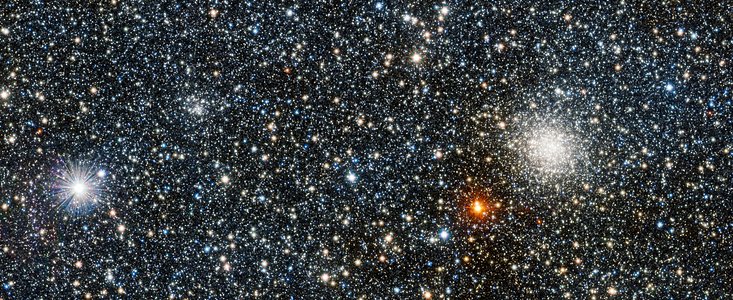Comunicato Stampa
VISTA scova nuovi ammassi globulari
e vede al di là del cuore della Via Lattea
19 Ottobre 2011

Due nuovi ammassi globulari, trovati nelle recenti immagini di VISTA, il telescopio per survey del’ESO, nel corso della survey della Via Lattea detta VVV, sono appena stati aggiunti ai soli 158 già noti nella Via Lattea. La survey VVV ha anche scoperto il primo ammasso stellare che si trova ben oltre il centro della Galassia e la cui luce ha dovuto attraversare la polvere e il gas nel cuore dalla galassia per raggiungerci.
Lo sfolgorante ammasso globulare noto come UKS 1 domina la parte destra della prima nuova immagine infrarossa di VISTA, il telescopio per survey dell’ESO all’osservatorio del Paranal in Cile. Se potete distogliere lo sguardo, però, una sorpresa vi attende in questo campo stellare così ricco – un ammasso globulare più debole, scoperto proprio nei dati di una delle survey di VISTA. Dovete guardare attentamente per individuare questo secondo ammasso stellare, chiamato VVV CL001: è una piccola raccolta di stelle nella metà sinistra dell’immagine, appena sopra il centro.
Ma VVV CL001 è solo la prima delle scoperte di VISTA a proposito di ammassi globulari. Lo stesso gruppo ha trovato un secondo oggetto, chiamato dunque VVV CL002, mostrato nell’immagine b [1]. Questo raggruppamento così piccolo e debole potrebbe essere l’ammasso globulare più vicino al centro dalla Via Lattea. La scoperta di un nuovo ammasso globulare nella nostra galassia è un evento molto raro. Solo 158 ammassi globulari erano noti nella nostra galassia prima di queste nuove scoperte, l’ultimo identificato nel 2010.
Questi nuovi ammassi sono le primizie della survey VVV (VISTA Variables in the Via Lactea), che studia sistematicamente la parte centrale della Via Lattea in luce infrarossa. L’equipe di VVV è guidata da Dante Minniti (Pontificia Universidad Católica, Cile) e Philip Lucas (Centre for Astrophysics Research, University of Hertfordshire, UK).
Oltre agli ammassi globulari, VISTA sta trovando molti ammassi aperti (o galattici) che di norma contengono meno stelle, più giovani di quelle negli ammassi globulari, e sono anche molto più frequenti (eso1128). È stata appena annunciata la scoperta di un altro ammasso, VVV CL003, che sembra essere un ammasso aperto nella direzione del cuore della Via Lattea, ma molto più lontano, circa 15 000 anni luce al di là del centro. Questo è il primo ammasso di questo tipo scoperto nel “lato opposto” della Galassia.
Vista la tenuità degli ammassi appena trovati, non c’è da meravigliarsi che questi siano rimasi nascosti per così tanto tempo; fino a pochi anni fa UKS 1 (nell’immagine a) che senza difficoltà offusca i nuovi arrivati, era il più debole ammasso globulare noto nella Via Lattea. A causa dell’assorbimento e dell’arrossamento della luce stellare dovuti alla polvere interstellare, questi oggetti sono visibili solo nella banda infrarossa e VISTA, il più grande telescopio al mondo per survey, è lo strumento ideale per cercare nuovi ammassi nascosti dietro la polvere che avvolge le zone centrali della Via Lattea [2].
Un’interessante possibilità è che VVV CL001 sia legato gravitazionalmente a UKS 1 – rendendo questi due gruppi di stelle la prima coppia di ammassi globulari binari. È anche vero che questo potrebbe essere semplicemente un effetto di proiezione: i due ammassi sono allineati sulla linea di vista, ma la loro distanza reale è molto grande.
Queste immagini di VISTA sono state prodotte a partire da dati ottenuti con filtri del vicino infrarosso: J (in blu), H (in verde) e Ks (in rosso). Le immagini mostrano solo una piccola parte dell’intero campo osservabile da VISTA.
Note
[1] La scoperta di nuovi ammassi stellari è stata annunciata in San Juan, Argentina, durante il primo incontro bi-nazionale delle associazioni astronomiche argentina e cilena.
[2] I minuscoli granelli di polvere che formano vaste nubi all’interno delle galassie diffondono la luce blu più di quella rossa e infrarossa. Ne risulta che gli astronomi possono utilizzare la luce infrarossa per vedere attraverso la polvere con maggiore efficienza che utilizzando la normale radiazione visibile a cui i nostri occhi sono sensibili.
Ulteriori Informazioni
L’ESO (European Southern Observatory) è la principale organizzazione intergovernativa di Astronomia in Europa e l’osservatorio astronomico più produttivo al mondo. È sostenuto da 15 paesi: Austria, Belgio, Brasile, Danimarca, Finlandia, Francia, Germania, Gran Bretagna, Italia, Olanda, Portogallo, Repubblica Ceca, Spagna, Svezia, e Svizzera. L’ESO svolge un ambizioso programma che si concentra sulla progettazione, costruzione e gestione di potenti strumenti astronomici da terra che consentano agli astronomi di realizzare importanti scoperte scientifiche. L’ESO ha anche un ruolo di punta nel promuovere e organizzare la cooperazione nella ricerca astronomica. L’ESO gestisce tre siti osservativi unici al mondo in Cile: La Silla, Paranal e Chajnantor. Sul Paranal, l’ESO gestisce il Very Large Telescope, osservatorio astronomico d’avanguardia nella banda visibile e due telescopi per survey. VISTA, il più grande telescopio per survey al mondo, lavora nella banda infrarossa mentre il VST (VLT Survey Telescope) è il più grande telescopio progettato appositamente per produrre survey del cielo in luce visibile. L’ESO è il partner europeo di un telescopio astronomico di concetto rivoluzionario, ALMA, il più grande progetto astronomico esistente. L’ESO al momento sta progettando l’European Extremely Large Telescope o E-ELT (significa Telescopio Europeo Estremamente Grande), della classe dei 40 metri, che opera nell'ottico e infrarosso vicino e che diventerà “il più grande occhio del mondo rivolto al cielo”.
Links
- Articoli scientifici pubblicati su A&A: Minniti et al A&A, 527, 81 & Moni Bidin et al. astro-ph:1109.1854
- Immagini di VISTA
Contatti
Dante Minniti
Pontificia Universidad Católica de Chile
Santiago, Chile
Tel.: +56 2 463 3267
E-mail: dante@astro.puc.cl
Maren Hempel
Pontificia Universidad Católica de Chile
Santiago, Chile
Tel.: +56 2 354 4945
E-mail: mhempel@astro.puc.cl
Christian Moni Bidin
Universidad de Concepción
Concepción, Chile
Tel.: +56 9 9210 3235
E-mail: cmbidin@astro-udec.cl
Richard Hook
ESO, La Silla, Paranal, E-ELT and Survey Telescopes Public Information Officer
Garching bei München, Germany
Tel.: +49 89 3200 6655
Cell.: +49 151 1537 3591
E-mail: rhook@eso.org
Anna Wolter (press contact Italia)
Rete di divulgazione scientifica dell'ESO
e INAF-Osservatorio Astronomico di Brera
Milano, Italy
Tel.: +39 02 72320321
E-mail: eson-italy@eso.org
Sul Comunicato Stampa
| Comunicato Stampa N": | eso1141it |
| Nome: | VVV CL001, VVV CL002, VVV CL003, VVV Survey |
| Tipo: | Milky Way : Star : Grouping : Cluster : Globular |
| Facility: | Visible and Infrared Survey Telescope for Astronomy |
| Instruments: | VIRCAM |
| Science data: | 2011A&A...535A..33M 2011A&A...527A..81M |
Our use of Cookies
We use cookies that are essential for accessing our websites and using our services. We also use cookies to analyse, measure and improve our websites’ performance, to enable content sharing via social media and to display media content hosted on third-party platforms.
ESO Cookies Policy
The European Organisation for Astronomical Research in the Southern Hemisphere (ESO) is the pre-eminent intergovernmental science and technology organisation in astronomy. It carries out an ambitious programme focused on the design, construction and operation of powerful ground-based observing facilities for astronomy.
This Cookies Policy is intended to provide clarity by outlining the cookies used on the ESO public websites, their functions, the options you have for controlling them, and the ways you can contact us for additional details.
What are cookies?
Cookies are small pieces of data stored on your device by websites you visit. They serve various purposes, such as remembering login credentials and preferences and enhance your browsing experience.
Categories of cookies we use
Essential cookies (always active): These cookies are strictly necessary for the proper functioning of our website. Without these cookies, the website cannot operate correctly, and certain services, such as logging in or accessing secure areas, may not be available; because they are essential for the website’s operation, they cannot be disabled.
Functional Cookies: These cookies enhance your browsing experience by enabling additional features and personalization, such as remembering your preferences and settings. While not strictly necessary for the website to function, they improve usability and convenience; these cookies are only placed if you provide your consent.
Analytics cookies: These cookies collect information about how visitors interact with our website, such as which pages are visited most often and how users navigate the site. This data helps us improve website performance, optimize content, and enhance the user experience; these cookies are only placed if you provide your consent. We use the following analytics cookies.
Matomo Cookies:
This website uses Matomo (formerly Piwik), an open source software which enables the statistical analysis of website visits. Matomo uses cookies (text files) which are saved on your computer and which allow us to analyze how you use our website. The website user information generated by the cookies will only be saved on the servers of our IT Department. We use this information to analyze www.eso.org visits and to prepare reports on website activities. These data will not be disclosed to third parties.
On behalf of ESO, Matomo will use this information for the purpose of evaluating your use of the website, compiling reports on website activity and providing other services relating to website activity and internet usage.
Matomo cookies settings:
Additional Third-party cookies on ESO websites: some of our pages display content from external providers, e.g. YouTube.
Such third-party services are outside of ESO control and may, at any time, change their terms of service, use of cookies, etc.
YouTube: Some videos on the ESO website are embedded from ESO’s official YouTube channel. We have enabled YouTube’s privacy-enhanced mode, meaning that no cookies are set unless the user actively clicks on the video to play it. Additionally, in this mode, YouTube does not store any personally identifiable cookie data for embedded video playbacks. For more details, please refer to YouTube’s embedding videos information page.
Cookies can also be classified based on the following elements.
Regarding the domain, there are:
- First-party cookies, set by the website you are currently visiting. They are stored by the same domain that you are browsing and are used to enhance your experience on that site;
- Third-party cookies, set by a domain other than the one you are currently visiting.
As for their duration, cookies can be:
- Browser-session cookies, which are deleted when the user closes the browser;
- Stored cookies, which stay on the user's device for a predetermined period of time.
How to manage cookies
Cookie settings: You can modify your cookie choices for the ESO webpages at any time by clicking on the link Cookie settings at the bottom of any page.
In your browser: If you wish to delete cookies or instruct your browser to delete or block cookies by default, please visit the help pages of your browser:
Please be aware that if you delete or decline cookies, certain functionalities of our website may be not be available and your browsing experience may be affected.
You can set most browsers to prevent any cookies being placed on your device, but you may then have to manually adjust some preferences every time you visit a site/page. And some services and functionalities may not work properly at all (e.g. profile logging-in, shop check out).
Updates to the ESO Cookies Policy
The ESO Cookies Policy may be subject to future updates, which will be made available on this page.
Additional information
For any queries related to cookies, please contact: pdprATesoDOTorg.
As ESO public webpages are managed by our Department of Communication, your questions will be dealt with the support of the said Department.







